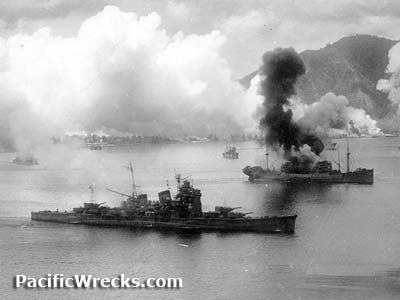|
|
|
| Missing In Action (MIA) | Prisoners Of War (POW) | Unexploded Ordnance (UXO) |
| Chronology | Locations | Aircraft | Ships | Submit Info | How You Can Help | Donate |
|
| IJN Myōkō-class Heavy Cruiser 13,300 Tons 661' 9" x 68' x 20' 9" 10 x 203mm guns 6 x 120mm guns 8 x 127mm guns 2 x 13mm MG 12 x torpedo tubes two seaplanes  3rd BG Nov 2, 1943 |
Ship History Built by Mitsubishi Shipbuilding at Nagasaki. Laid down March 16, 1925 as hull No. 420 on the no. 2 slipway as s Myōkō-class Heavy Cruiser. Launched March 24, 1928 as Haguro 羽黒 named after Mount Haguro (Mt. Haguro) in Yamagata Prefecture in Japan armed with 200mm 50 cal Type 3 (No. 1) guns. On October 1, 1929 Captain Keitaro Hara was assigned as chief equipping officer. Commissioned April 25, 1929 in the Imperial Japanese Navy (IJN) attached to Sasebo Naval District with Captain Keitaro Hara in command. On November 30, 1929 assigned to Captain Sekizo Uno. On October 22, 1930 embarked Emperor Hirohito and his entourage who spent two nights aboard then disembarked at Kirishima. On December 1, 1930 Captain Sonosuke Kobayashi assumes command. On October 10, 1931 Captain Naokuni Nomura assumes command. On February 14, 1933 Captain Jo Morimoto assumes command. On November 15, 1933 Captain Minoru Yamaguchi assumes command. On November 15, 1935 Captain ( Samejima Tomoshige assumes command. During 1936 at Sasebo undergoes reconstruction at Sasebo Navy Yard with her her original main guns replaced with with 203mm guns (No. 2) with work completed by June 29, 1936. On April 28, 1941 the second reconstruction was completed at the Kure Naval Arsenal. Assigned to Captain M. Terado. Wartime Service On December 31, 1941 returns to Davao Harbor. On January 4, 1942 attacked the U.S. Navy anchorage in Malalag Bay then returns to Davao. While anchored at Davao Harbor, a B-17 Flying Fortresses from Java bombs Haguro, but fails to cause any damage. On January 9, 1941 departs Davao Harbor as part of "Operation H" the invasion of Celebes covering the Japanese landings at Menado and Kema on January 11, 1941 until January 14, 191 and Kendari on January 24, 1941. Two days later, USS Sailfish (SS-192) claims torpedo hits on Haguro, but the ship was not damaged. On January 29-31 1942 depart Davao for Bangka Roads off Celebes to cover the landing at Ambon. Afterwards, supports the landings at Makassar February 5-10. Engaged the enemy off Makassar on February 8. Afterwards, landings at Dili and Kupang on February 17-20. Departs Staring Bay on February 24. Two days later, her E13 Jake is damaged while being lifted aboard and the pilot injured. On February 27, 1942 participated in the Battle of the Java Sea and participated in the sinking of HMS Exeter and HMS Encounter. On March 1, 1942 engaged in another action off southern Borneo. PARTIAL LIST On May 7, 1942 participated in the Battle of the Coral Sea. Afterwards, took part in the Battle of the Eastern Solomons on 24 August 1942. In late January 1943, assisted with the the Japanese evacuation from Cape Esperance on Guadalcanal. PARTIAL LIST On November 2, 1943 in the early morning during in the Battle of Empress Augusta Bay engaged U.S. Navy Task Force 39 (TF 39) light cruisers and destroyers. During the engagement, Haguro sustains light damage. By 3:37am disengages and returns to Simpson Harbor. Later that morning, targeted by U.S. Army Air Force (USAAF) 5th Air Force B-25 Mitchells on a low level strike against Rabaul. During the air raid, Haguro was not damaged. During the air raid, a B-25 Mitchell from 3rd Bomb Group (3rd BG) at low level photograhed Haguro. PARTIAL LIST On June 19, 1944 she survived the Battle of the Philippine Sea.PARTIAL LIST Sinking History Rescue Her foremast and the top half of the bridge structure are missing/collapsed. Her mainmast is collapsed. Her funnels are missing. British hits are visible in places. The bow section forward of No. 2 turret is decimated. The No. 1 turret and barbette were completely uprooted and now lay across the wreck, the rear of the turret on the starboard sea bed and the barrels pointing vertically towards the surface. Her No. 2 turret is trained to starboard at approximately the 1 o’clock position, with its roof collapsed and both barrels and breach blocks missing (not replaced after bomb damage at Leyte Gulf). The no. 3 turret guns are askew and trained to the port quarter in the 8 o’clock position. Both her stern main turret guns point almost directly astern. Just behind the no. 5 turret, the wreck is broken completely in half, although the stern section is still partially attached and heavily damaged on the port side. Contribute
Information Last Updated
|
Lat 4 49N Long 99 42E 220' / 67m |
| Discussion Forum | Daily Updates | Reviews | Museums | Interviews & Oral Histories |
|